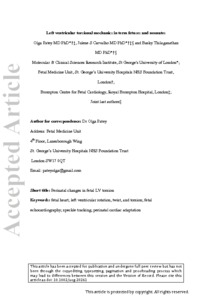Patey, O; Carvalho, JS; Thilaganathan, B
(2020)
Left ventricular torsional mechanics in term fetuses and neonates.
Ultrasound Obstet Gynecol, 55 (2).
pp. 233-241.
ISSN 1469-0705
https://doi.org/10.1002/uog.20261
SGUL Authors: Thilaganathan, Baskaran
![[img]](https://openaccess.sgul.ac.uk/110787/1.hassmallThumbnailVersion/uog.20261.pdf)  Preview |
|
PDF
Accepted Version
Available under License ["licenses_description_publisher" not defined].
Download (1MB)
| Preview
|
Abstract
Objective
Left ventricular (LV) torsion is an important aspect of cardiac mechanics and is fundamental to normal ventricular function. The myocardial mechanics of the fetal heart and the changes that occur during the transition to the neonatal period have not been explored previously. The aim of this study was to evaluate perinatal changes in LV torsion and its relationship with myocardial function.
Methods
This was a prospective study of 36 women with an uncomplicated term pregnancy. Fetal and neonatal conventional, spectral tissue Doppler and two‐dimensional (2D) speckle tracking echocardiography were performed a few days before and within hours after delivery to measure cardiac indices including LV rotational parameters derived from short‐axis views at the base and apex of the heart. Linear regression analysis was used to examine the relationship between LV rotational parameters and cardiac geometric and functional indices in term fetuses and neonates. Perinatal changes in LV rotational parameters were assessed.
Results
There were three patterns of LV twist in term fetuses: those with reversed‐apex‐type LV twist had the lowest median values of LV torsion (0.1°/cm), with higher values (1.6°/cm) in those with infant‐type LV twist and the highest values (4.4°/cm) in those with adult‐type LV twist. LV torsion was associated significantly with cardiac geometric and functional indices. Perinatal evaluation revealed a significant increase in LV torsion following delivery in fetuses exhibiting reversed‐apex‐type LV twist (increase of 2.8°/cm, P = 0.009) and a significant decrease in those with adult‐type LV twist (decrease of 3.2°/cm, P = 0.008).
Conclusions
This study demonstrates the feasibility of 2D speckle tracking imaging for accurate assessment of rotational cardiac parameters in term fetuses. There are unique perinatal patterns of LV twist that demonstrate different values of LV torsion, which was found to correlate with indices of ventricular geometry and myocardial function. Differences in patterns of LV twist may therefore reflect differences in compensatory myocardial adaptation to the physiological environment/loading conditions in late gestation in fetuses and postnatal cardiac adjustment to the acute loading changes that occur at delivery.
| Item Type: |
Article
|
| Additional Information: |
This is the peer reviewed version of the following article: Patey, O., Carvalho, J.S. and Thilaganathan, B. (2020), Left ventricular torsional mechanics in term fetuses and neonates. Ultrasound Obstet Gynecol, 55: 233-241, which has been published in final form at https://doi.org/10.1002/uog.20261. This article may be used for non-commercial purposes in accordance with Wiley Terms and Conditions for Use of Self-Archived Versions. |
| Keywords: |
fetal echocardiography, fetal heart, left ventricular rotation, twist, and torsion, perinatal cardiac adaptation, speckle tracking, 1114 Paediatrics And Reproductive Medicine, Obstetrics & Reproductive Medicine |
| SGUL Research Institute / Research Centre: |
Academic Structure > Molecular and Clinical Sciences Research Institute (MCS) |
| Journal or Publication Title: |
Ultrasound Obstet Gynecol |
| ISSN: |
1469-0705 |
| Language: |
eng |
| Dates: |
| Date | Event |
|---|
| 3 February 2020 | Published | | 8 January 2020 | Published Online | | 12 March 2019 | Accepted |
|
| Publisher License: |
Publisher's own licence |
| Projects: |
| Project ID | Funder | Funder ID |
|---|
| UNSPECIFIED | Children's Heart Unit Fund | UNSPECIFIED | | UNSPECIFIED | Royal Brompton and Harefield Hospital Charity | UNSPECIFIED | | 14EDI01 | SPARKS Charity | UNSPECIFIED |
|
| PubMed ID: |
30887619 |
 |
Go to PubMed abstract |
| URI: |
https://openaccess.sgul.ac.uk/id/eprint/110787 |
| Publisher's version: |
https://doi.org/10.1002/uog.20261 |
Statistics
Item downloaded times since 02 Apr 2019.
Actions (login required)
 |
Edit Item |



